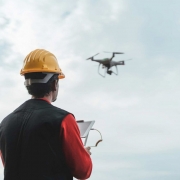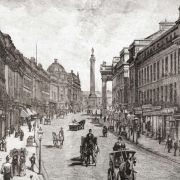Technology and Its Positive Effects On Construction Safety
Technology has played an important role in making construction sites safer and more efficient.
For example, with improved remote communications, employers can do more to ensure the safety of their work crews and job sites. This article expands on the role of technology in construction safety, especially in equipment with improved safety measures.
Why Keep Construction Sites Safe?
Construction can be dangerous for workers. In a 2017 report, construction ranked as a major cause of workplace fatalities, accounting for one-fifth of workers’ deaths for the year. A larger percentage of these deaths, 59.9%, is associated with one of four causes;
Falls – This is the most prominent cause of construction death – 386 construction workers died from falls in 2017.
Object Strikes – 8.2% of construction fatalities in 2017 were attributed to being hit by falling or flying objects.
Electrocution – In third place is electrocution – 7.3% of construction workers’ deaths in 2017 resulted from electrocution.
Caught by Objects – A considerable number of construction crew members died from being compressed by objects or caught between two objects. This accounted for 5.1% of recorded death.
The government has empowered the Occupational Safety and Health Administration (OSHA) to enforce regulations preventing injuries and deaths on construction sites in different industries. Some of these regulations are specific to construction. For example, employers are expected to protect their workers from falls by adhering to OSHA guidelines when it comes to fall protection. Scaffolding is another top regulation, with employers required to set up safe and stable scaffolding to prevent objects and crew members from falling, in line with OSHA’s requirements. OSHA also mandates employers to ensure ladders are used safely on jobsites.
There are other general industry violations, most of which entail the usual construction site hazards. These include powered industrial trucks, failing to wear the right respiratory or eye protection gear, adequately dealing with hazardous energy sources, and not training employees in fall protection. The need to keep construction sites safe cannot be overemphasized. Interestingly, only newer and innovative technologies can solve these problems. For example, the safety and productivity of crew members can now be tracked easily, eliminating risks like fatigued operators, equipment problems, and workers ending up in dangerous positions.
Role of Technology in Construction
Construction has always been about the use of heavy, mechanical equipment. Contrary to popular views, these pieces of machinery have not been relegated. Instead, most of them have found their way into the current construction setting alongside other top innovations. It is even more exciting to note that further innovations are waiting to be tested and cleared for use in the field.
There are tons of problems to be solved on jobsites, particularly about safety. That is why construction companies develop innovative ideas and solutions to keep their workers and equipment safe. The current construction machinery is designed to ensure safety, especially for the operators and other on-site people. While these safer and innovative solutions translate to significant financial investments, companies get excellent returns by spending less on injury compensations and productivity lost to downtime and accidents.
Technology in Construction Safety
More companies are looking into adopting technology to make their worksites safer and more efficient. These multiple methods of adoption include the use of drones, tracked equipment, and wearable technology. However, having so many options also come with a downside – choosing the right safety gear or feature is somewhat tricky. So, it is essential to do a safety evaluation to understand what areas of your site require improvement and the best gears to meet these requirements. The goal should be to improve in areas that most needs improved safety, thereby maximizing your investment in technology.
Let’s look at some of the technology solutions available to construction employers;
1. Drones
Most drones today are equipped with cameras offering a clear overview of the construction site. This eliminates the attending risk of using workers to achieve the same aim. It is an effective way of tracking your workers’ activities, ensuring they adhere to safety protocols. Drones are consumer products – you will find them in the most reputable electronics stores around. They are available in different models and sizes.
Some advanced heavy-duty drones can carry minimal weights around the construction site. The extra lift in such drones comes in handy on multi-story jobsites or when working on a vast land area. Drones are not only faster but also more flexible and safer. The drone cameras also give workers visual access to areas that appear too dangerous for humans. For instance, a drone can better ensure safety and maximum productivity instead of sending a worker for a demolition inspection or bridge inspection.
2. Smart Gears and Clothing
Personal Protective Equipment (PPE) protects the wearer’s body from worksite hazards. Technology brought about PPEs in the workplace, especially in clothes worn for protection. These include hard hats with carbon monoxide and detectors embedded inside. These hats can detect the presence of CO and alert the wearer of this odorless, colorless, and dangerous gas.
There are other types of smart clothing, most of which are connected to an extensive information grid. For example, a geofence, an electronic virtual barrier, can alert supervisors of a breach and alarms with sounds that go off when workers approach prohibited areas. In addition, some smart garments can effectively track the physical signs of workers, including skin temperature, heart rate, and breathing. The supervisors can monitor these signs and recommend a break and adequate treatment where necessary. There are also specialized sensors that can detect the posture of a worker – a standard indicator of work fatigue.
3. Virtual Reality and Augmented Reality
Recent training for new operators now contains virtual and/or augmented reality. Virtual reality exposes users to a 100% computer-generated world, where they learn foundational machine operation and safety techniques. Augmented reality is the more advanced version – it puts a computerized overlay over a pair of clear glasses, allowing users to interact with the world around them. Augmented reality comes up with multiple real-life situations in the form of virtual challenges and requires the controller to interact with and control these situations via a particular machine.
A comprehensive VR/AR training prepares operators for good and safe use of heavy equipment associated with their job descriptions. With AR, operators can easily detect dangers around them. For example, the special AR helmets can see alert signs when a user is nearing a possibly dangerous part of the worksite. Employers can also regulate the information accessible to workers to keep them safe and focused.
4. Mobile Reporting
It is far easier and more efficient to track the location of employees if they are wearing GPS-enabled mobile devices. Such mobile devices can also document events of safety violations or similar situations on the jobsite. Based on the recorded information, supervisors can determine the exact location the problem occurred and prevent a future occurrence.
Unlike conventional reporting, mobile reporting occurs as soon as the problem occurs. Mobile reporting is also easier than walk-in reporting; the reporter stays anonymous while reporting the incident. The issues on jobsites are better tracked with mobile reporting, leading to improved productivity and safety on the jobsite.
However, mobile reporting is not perfect. For example, these mobile devices will only work on worksites with internet access. In addition, real-time monitoring and reporting of incidents are impossible without cellular activity. If you are in a remote jobsite with weak cell signals, you may resort to local sensors as your go-to site monitoring medium.
5. Site Monitoring
The health and safety of workers and crew on a jobsite depend considerably on the environmental conditions. Supervisors can make better decisions regarding safety when they can adequately monitor temperature, noise, dust, and chemical levels around the site. This is achievable by installing specialized sensors designed to monitor the environmental conditions of the worksite.
With access to real-time and accurate environmental data, supervisors can spot issues faster and proffer suitable solutions that keep everyone safe.

Cat® Technology for Better Worksite Safety
Every piece of Caterpillar® machinery is made with workers’ safety in mind. Downtime from injuries can slow the progress of a project and introduce unplanned costs. Caterpillar includes an inbuilt safety technology in all of its vehicles and offers wearable safety gears to ensure workers’ protection. All these ensure everyone is safe, especially operators and worksite crew.
Let’s take a look at these technologies and devices:
1. Cat Connect
The Cat Connect line of technology is designed to improve the safety and productivity of Cat heavy equipment. It combines efficient software and hardware in machinery to keep workers safe from injury resulting from worksite activities. This is an effective way of keeping your fatality statistics on construction sites low while ensuring minimum downtime.
2. Inbuilt Operator Monitoring
Freeways and construction sites have two things in common: driver fatigue and distractions. But unlike cars that cannot prevent these disturbances, Cat vehicles are equipped with inbuilt operator monitoring systems that prevent dangerous driving.
The cab section of Cat machinery usually comes with sensors that track the head and eye movement of the operators. These sensors look out for differences that could point to driver distraction. It is effective for drivers wearing sunglasses or operating the vehicle at night.
If the system detects variations that suggest the driver is not focused enough on operating the vehicle, it sounds an alarm, and the seat vibrates. This is to alert and get them to refocus. Plus, the Caterpillar Safety Advisors record the incident for further assessment by the supervisor.
Fatigue is also major issue operators tend to deal with on worksites. Inbuilt fatigue sensors in the cabs are designed to track unusual fatigue-related movements like consecutive nods or closed eyes. Either of these triggers the alarm and vibrates the seat. The incident is reported immediately to the supervisor. Based on this report, the supervisor can withdraw the operator from duty and allow them to rest sufficiently.
Cat driver safety systems are flexible. The monitoring equipment can be in any heavy equipment on your worksite, both new and used. While some of these safety features are only factory-fitted in some more recent vehicles, you can install the driver safety system manually in your older fleet. Now you can keep your worksite safe and productive without buying newer Cat machinery. Aftermarket Caterpillar parts are also useful for this.
3. Remote-Controlled Equipment
Drones are known for their mobility, which comes in handy when trying to access dangerous areas. Caterpillar integrates this fundamental idea on a larger scale in their heavy equipment. When using Cat machinery in hazardous situations, you can control the vehicle remotely rather than designating an actual operator. This is made possible by the Cat remote control choice of Cat Connect. It comes in two options, both of which can be installed into a new vehicle provided you request while ordering.
The first is the line-of-sight operation, which allows the operator to control the vehicle from a safe distance on-site. It works effectively without a high-speed data connection. All the operator needs to do is be within sight of the vehicle. This option comes in handy for emergency remote operation needs. The second remote operation is the remote location, which requires a high-speed data connection and a centralized control station where operators can remotely control vehicles. The remote location option is better for long-time remote control of vehicles. Still, it requires a high-speed wireless data connection to ensure real-time and uninterrupted communication of controls.
4. Worker Detection Systems
The Cat Detect relies on multiple methods to notify operators of where other workers are on the construction site at any point in time. The underlying passive radio frequency identification (RFID) technology ensures the response is never a false positive, making it easier for an operator to know exactly where other people are while using the vehicle. This is an efficient way of reducing the number of accidents on site.
The first step is to install a small RFID sensor into every worker’s reflective vest and hard hat. These washable sensors work without a power supply and can be on at all times. Unlike active RFID sensors, these devices are passive and emit no radio waves. The second step is to install a detector on the vehicle, which sends out radio waves in search of the small RFID sensors. The radio waves are so strong that they can detect the sensors in workers lying and sitting on the ground.
Once the detector identifies a sensor, it sends corresponding audio and visual signals to the driver via the in-cab display to alert them of a worker nearby.
5. Wearables that Detect Fatigue
It is common to see construction site operators try to fight against fatigue. However, no one can beat nature. Even the most energetic operators cannot force their bodies to work against tiredness. Sleepiness sets in, leading to accidents caused by the loss of control of the heavy machinery. Therefore, a tired operator is dangerous to themselves and everyone else on the construction site.
Caterpillar has found a way to prevent these ugly scenarios. Its proprietary wearable technology can track all workers’ fatigue levels, provided they are wearing the Cat smart band. First, the smart band collects data about sleep patterns, circadian rhythms, and other relevant metrics to estimate fatigue. Then, the band integrates this data into a special software that relies on bio-mathematical science to predict fatigue-induced sleep before it happens.
This prediction is premised on a fatigue score estimated from the recorded sleep patterns uploaded to the cloud from the user’s smart band. The fatigue score of every operator is checked once they arrive on site, and based on this and other users’ ratings, a report is formed. This report can help supervisors decide who is most likely to stay awake long enough to operate the vehicle safely.
In most cases, the report contains the already-estimated number of hours a worker can stay awake to work optimally. Once a worker reaches this limit, the supervisor can withdraw them from duty for a much-needed rest. If the fatigue score of a worker is below 70, there is a good chance such a worker will feel and react like they are drunk driving. Having such employees on a jobsite is outrightly dangerous to themselves and everyone around.
Ensuring fatigued workers do not end up in the operator’s seat or anywhere else on the site is an effective way of avoiding accidents, minimizing downtime, and maximizing productivity. However, tired workers are more prone to wrong decisions and errors, leading to downtime and a drop in productivity. With this technology, supervisors can identify fatigued workers early and pull them off the jobsite before it is too late.
In Conclusion
Safety on a construction site is everybody’s business. Unfortunately, a single construction site worker’s negligence can affect others. That is why employers and supervisors must take safety seriously. Fortunately, technology has made it easier to keep jobsites safe and productive. This article has presented several tech-backed safety recommendations supervisors can adopt to keep their worksite free of accidents. Caterpillar®, as a renowned heavy equipment manufacturer, also has multiple safety technologies and devices specially created to prevent downtime and additional costs caused by worksite accidents. These technologies are open to both new and existing caterpillar fleets, and while they may appear expensive at first, they present excellent ROI in the long run.



